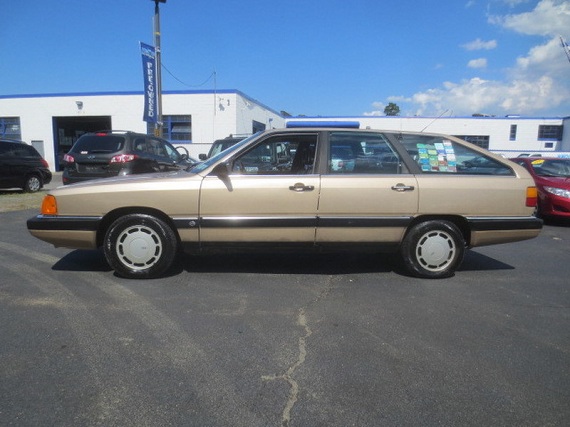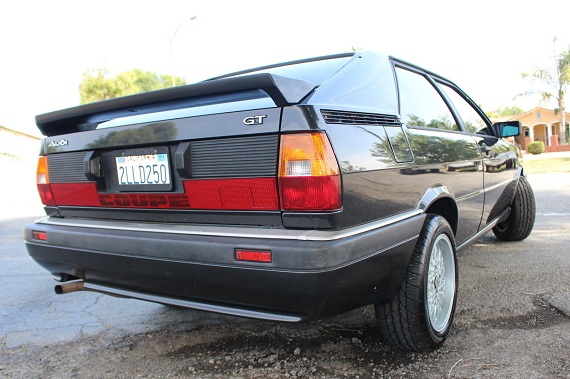Despite praise from critics when it was new, a great design by Giugiaro and a motorsports legacy second to none, the Audi Coupe GT has remained since new a fringe car in the United States. Compared to the E30 2-doors, Audi produced less than half the total production of BMW’s venerable small coupe with only around 170,000 made over its 8 year production run. Of those, many less were imported to the United States and even fewer survive today. They’re downright rare to see running around anywhere – the legacy of poor residual value more than anything. Those that have owned them love them – a great looking, unique coupe with awesome handling that is both at home on the highway and back roads. It’s easily capable of carrying a sizable load of adults and luggage since, like the E30, the GT shared its platform with a sedan – but where the GT differed was in drivetrain layout and the slinky roofline that has helped the car age particularly well. On paper, the GT doesn’t make a great driver – a big iron lump hanging out entirely ahead of the front axle line to allow for the all-wheel drive system we didn’t see in the GT on these shores, an open differential and a slightly heavier curb weight without much more power than the coupes from Volkswagen. But statistics don’t tell the whole story, and GT is a great example of that. Extremely well balanced and neutral out of the box, the longer wheelbase provides excellent stability while the equal-length driveshafts eliminate torque steer and help to put power down better than the Volkswagens. The package is refined and shows why the GT was successful in its own right as a racer in Europe. Plus, you get that wonderful off-beat, throaty inline-5 providing one of the more unique soundtracks from the 1980s:
Tag: KX
It goes without saying that not every older German car is perfect, and that leaves a large amount of cars that are a bit of a “project”. Depending on your tolerance and your desire for a particular model, that level of project can vary greatly from a car that has some minor needs to a complete rebuild from scratch. Today I have two “broken” Silver Arrows from different generations – each with a devoted following and somewhat rare to see these days. Both could function as daily drivers with some work if you’re game. Let’s start with the Coupe GT:
CLICK FOR DETAILS: 1984 Audi Coupe GT on eBay
8 CommentsWhen it comes to memorable Audis from the 1980s, the 5000 undeservedly gets little attention. That’s especially true when you back out the turbo and quattro versions of Audi’s flagship sedan. But in many ways it was the success of the large Audi sedans that allowed for the more exotic Quattro development – and the 5000 was a revolutionary success. Compared with what was on offer from rivals Mercedes-Benz and BMW at the time, the 5000 was downright futuristic and more modern in every way. It was an aerodynamic marvel, quiet and capable of returning excellent fuel economy. It was also hugely practical, too – especially when configured in hatchback Avant spec. Though the sloping rear glass dropped storage space a bit, it wasn’t much – and it’s amazing what can fit inside of these cars. Indeed, I used my 200 Avant to bring a complete 7A inline-5 home; the hatch actually assisted this since we could get the engine hoist over the car – something that would be impossible in most wagons. Still, most enthusiasts want the turbocharged quattro version, leaving the few front drivers that remain throwbacks to a time when a 120 horsepower large wagon was a reasonable option:
CLICK FOR DETAILS: 1987 Audi 5000S Avant on eBay
1 CommentDo you think you know Audi and Volkswagen products from the 1980s well? There are a lot of people who claim to, but it seems that at times even VAG didn’t know what it was producing. Take, for example, this 1986 Audi Coupe GT. Now, according to most sources for a long time, if you wanted to get the digital dashboard in a 1986 Audi Coupe GT, you had to get the “Commemorative Edition” GT which came only in white or graphite. Yet as the owner of what was originally a Oceanic Blue non-CE Audi GT with an original digital dashboard, I can attest that in fact cars outside of the normal production run were fitted with the somewhat quirky bit of 1980s fad technology. If you talk to most Audi folks, they stand firmly in two camps. The small camp says that the digital dash is really, really cool; the far larger camp sees it as a glitchy gimmick that seldom works properly and is hard to service. But having owned one for the best part of two decades now, I can say mine has never experienced much of an issue. It had neat features, such as the “shut off the entire dash” feature which left you only with a speed reading. I think I used it once, only to show someone that it existed. At startup, you could tell your friends that you had programmed the cover art to Ghost in the Machine by The Police into your dash. Much more fun, though, was the ability on the fly to switch the dash from English to Metric units; if you were alone on the highway with an unsuspecting passenger, you could flip the dash into metric and then brag about how you were going “150” with ease. Okay, maybe I was the only one who thought it was funny, but there really weren’t many advantages to the digital dash otherwise. Despite that a smattering of 1986 and 1987 (non-“Special Build”) cars, seemingly with no particular order or logic, were fitted with the Atari-esque bit of technology:



